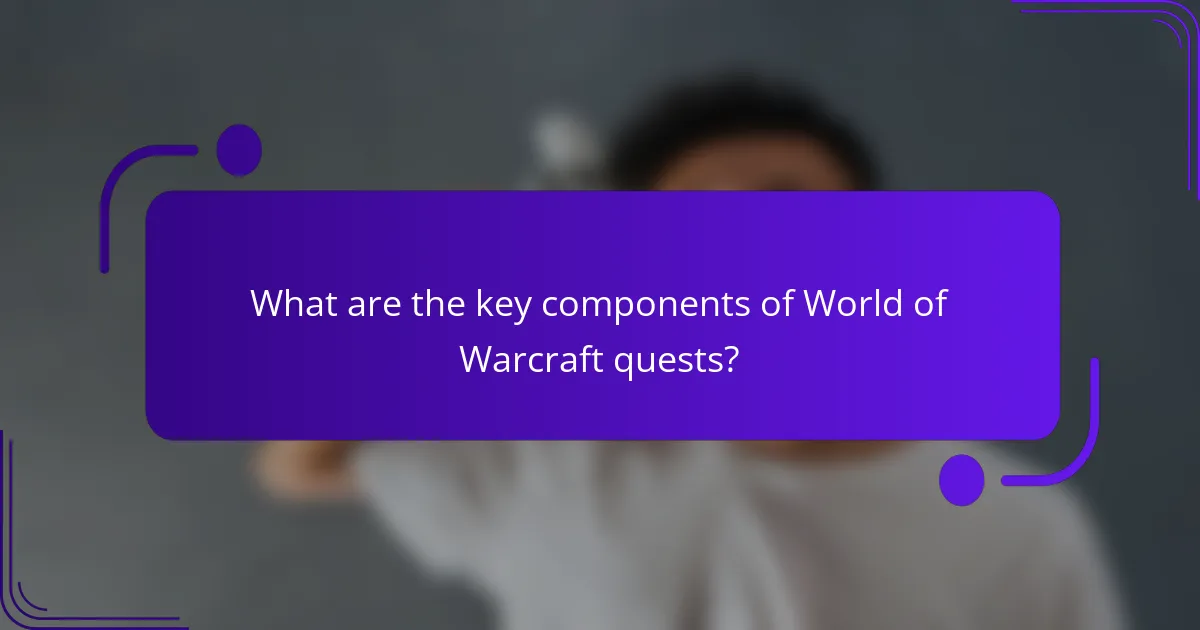World of Warcraft quests offer players engaging lore, diverse challenges, and valuable rewards. Explore various quest types, from main story arcs to daily tasks. Discover how narrative depth enhances gameplay and learn strategies for overcoming quest challenges. Uncover iconic quests that shape the game’s evolving story and enrich the player experience.

What are the key components of World of Warcraft quests?
World of Warcraft quests consist of lore, challenges, and rewards that enhance gameplay. Key components include quest types, narrative depth, objectives, and rewards.
Quest types vary, including main story quests, side quests, and daily quests. Each type serves different gameplay purposes, from advancing the story to providing additional challenges.
Narrative depth is crucial, as quests often weave into the larger lore of the game, enriching player experience. Objectives can range from defeating enemies to collecting items, requiring diverse gameplay strategies.
Rewards typically include experience points, gear, and in-game currency, motivating players to engage with the quest system. The combination of these components creates a dynamic and immersive experience.
How do quests drive the narrative in the game?
Quests drive the narrative in World of Warcraft by providing players with engaging storylines, character development, and immersive challenges. Each quest reveals lore that deepens the game’s mythology, allowing players to experience the world from multiple perspectives. Quests often introduce unique characters, enhancing emotional connections and driving player investment. Additionally, challenges within quests offer rewards that motivate progression, creating a cycle of engagement that fuels the overarching narrative.
What challenges do players face in completing quests?
Players face various challenges in completing quests in World of Warcraft, including resource management, time constraints, and coordination with other players. Many quests require specific items or abilities, which can lead to frustration if players lack the necessary resources. Additionally, some quests involve complex mechanics or require teamwork, making communication essential. The diverse environments and enemy types can also pose difficulties, as players must adapt their strategies accordingly. Overall, these challenges enhance the gameplay experience, encouraging players to develop skills and collaborate effectively.
Which rewards can players expect from quests?
Players can expect various rewards from quests, including experience points, gold, gear, and lore insights. Completing quests often leads to character progression and unlocking new storylines. Rewards vary by quest type, with rare quests offering unique items or achievements. Engaging in quests enhances the overall gaming experience in World of Warcraft.

How do quests vary across different expansions?
Quests in World of Warcraft vary significantly across expansions, focusing on different themes and gameplay mechanics. Each expansion introduces unique lore, challenges, and rewards that reflect the evolving narrative of the game.
For example, in “The Burning Crusade,” quests often center around the conflict with the Burning Legion, emphasizing exploration of new realms. In contrast, “Wrath of the Lich King” shifts focus to the battle against the Lich King, introducing more story-driven quests that deepen character development.
Later expansions, such as “Legion,” incorporate class-specific quests, enhancing player engagement through tailored experiences. Additionally, “Battle for Azeroth” features warfronts and faction-based quests, highlighting the ongoing conflict between the Alliance and Horde.
Overall, each expansion’s quests are designed to enrich the game’s lore and offer varied gameplay experiences, adapting to player interests and community feedback.
What unique quest types emerged in recent expansions?
Recent expansions in World of Warcraft introduced unique quest types like “Torghast, Tower of the Damned,” focusing on replayable dungeon experiences. Additionally, “Covenant Campaigns” allow players to explore distinct storylines tied to each faction. “World Quests” offer dynamic, time-limited objectives that change daily, enhancing gameplay variety. “Legendary Crafting Quests” require players to gather specific materials for powerful gear, creating a blend of exploration and crafting challenges. These quest types enrich the game’s lore and provide diverse rewards.
How do regional differences influence quest design?
Regional differences significantly influence quest design in World of Warcraft by shaping narrative themes, challenge levels, and reward systems. Different regions reflect local cultures, histories, and conflicts, creating quests that resonate with players. For example, quests in the Eastern Kingdoms often emphasize human struggles and alliances, while quests in Kalimdor may focus on tribal conflicts and nature. This diversity enhances player engagement and immersion, as each region offers unique lore and challenges that align with its distinct environment.
![]()
What are the most iconic quests in World of Warcraft?
The most iconic quests in World of Warcraft include the “Rite of Passage,” “The Battle for Mount Hyjal,” and “The Lich King’s Challenge.” These quests are renowned for their rich lore, challenging gameplay, and significant rewards.
The “Rite of Passage” quest showcases character development and personal growth, allowing players to experience transformative moments. “The Battle for Mount Hyjal” features epic battles against formidable foes, emphasizing cooperative gameplay. “The Lich King’s Challenge” presents one of the game’s most memorable encounters, blending storytelling with intense combat.
Each quest contributes to the overarching narrative of World of Warcraft, enhancing player engagement and immersion in the game’s universe.
Why are certain quests considered fan favorites?
Certain quests in World of Warcraft are considered fan favorites due to their engaging narratives, unique challenges, and rewarding experiences. Players often appreciate quests that deepen lore and character development. Iconic quests, such as “The Battle for Mount Hyjal,” showcase epic battles and rich storytelling. Additionally, quests that offer rare loot or achievements enhance player satisfaction. The combination of immersive environments and memorable characters contributes to their lasting appeal.
How do these iconic quests enhance gameplay experience?
Iconic quests enhance gameplay experience by providing immersive storytelling, challenging gameplay, and meaningful rewards. These quests deepen player engagement through rich lore that connects characters and events in the game world. Players face unique challenges that test their skills and strategy, fostering a sense of accomplishment. Rewards from these quests often include rare items and achievements, which further motivate players to explore and invest time in the game. Overall, iconic quests create a dynamic and rewarding environment that keeps players returning to World of Warcraft.

How do players strategize to overcome quest challenges?
Players strategize to overcome quest challenges by leveraging teamwork, optimizing character builds, and utilizing in-game resources. Effective communication is crucial for coordinating efforts during complex quests. Players often analyze quest mechanics and enemy behaviors to devise specific tactics. Additionally, they may consult online guides or community forums for insights on overcoming difficult challenges. Adapting strategies based on group composition and available skills enhances success rates significantly.
What common strategies are employed in difficult quests?
Difficult quests in World of Warcraft often employ strategies such as teamwork, resource management, and strategic planning. Players commonly collaborate in parties to tackle challenging objectives, utilizing diverse class abilities to overcome obstacles. Resource management is vital, ensuring players maintain health, mana, and consumables throughout the quest. Strategic planning includes scouting areas, understanding enemy mechanics, and timing actions for maximum efficiency. These strategies enhance the quest experience, making it rewarding and engaging.
How can teamwork impact quest completion?
Teamwork significantly enhances quest completion in World of Warcraft by fostering collaboration and strategy. Players can combine their skills, making it easier to tackle challenging quests that require diverse abilities. This cooperative approach often leads to quicker completion times and access to exclusive rewards. Additionally, teamwork can improve the overall quest experience, as players can share insights about lore and strategies, enriching their understanding of the game. Engaging with others also builds community, which can lead to lasting friendships and future collaborations in quests.

What role does lore play in shaping quests?
Lore is essential in shaping quests by providing context, motivation, and depth to player experiences. It enriches narratives, making quests more engaging and meaningful. Players connect with characters and storylines, enhancing immersion. Lore-driven quests often feature unique challenges and rewards tied to the overarching narrative, creating a cohesive game world. This integration fosters a sense of purpose and accomplishment, as players feel they contribute to the evolving story of Azeroth.
How does the backstory of an area influence quest narratives?
The backstory of an area significantly shapes quest narratives in World of Warcraft. It provides context, enriches character motivations, and influences player choices.
Lore serves as a foundation for quests, creating immersive experiences. For example, quests tied to historical events in a zone deepen engagement by connecting players to the world.
Character backgrounds often reflect the area’s history, driving narrative arcs. This connection fosters emotional investment, enhancing the quest’s impact on players.
Environmental storytelling also plays a role. Elements like ruins or artifacts hint at past events, guiding quest design and player exploration.
Which quests are most significant to the overarching lore?
The most significant quests in World of Warcraft lore include pivotal storylines that shape the game’s universe. Key quests such as “The Burning Crusade,” “Wrath of the Lich King,” and “Legion” define major conflicts and character arcs.
1. “The Burning Crusade” introduces the shattered world of Outland and the fight against the Burning Legion.
2. “Wrath of the Lich King” centers on the rise of Arthas Menethil and the battle for Northrend.
3. “Legion” explores the return of the Burning Legion and the alliance’s efforts to combat this existential threat.
4. “Cataclysm” reshapes Azeroth and highlights the consequences of Deathwing’s return.
5. “Mists of Pandaria” uncovers the hidden land of Pandaria and its ancient secrets.
6. “Battle for Azeroth” reignites the faction conflict between the Alliance and the Horde.
These quests are critical for understanding the overarching narrative and character development in the game.

What are the best practices for quest completion?
To complete quests effectively in World of Warcraft, players should follow these best practices: prioritize quest objectives, manage inventory wisely, utilize the map for navigation, and engage with NPCs for lore and additional tasks.
Understanding quest types enhances efficiency; for instance, gathering quests often require specific items, while kill quests demand defeating certain enemies. Grouping similar quests can save time and effort.
Players should also track quest progress through the in-game quest log, which provides essential details and updates. Communicating with other players can offer insights and strategies for challenging quests.
Finally, leveraging in-game tools, like addons, can streamline quest management and enhance the overall experience.
What common mistakes should players avoid?
Players should avoid common mistakes that can hinder their questing experience in World of Warcraft. Failing to read quest descriptions can lead to confusion and wasted time. Neglecting to manage inventory efficiently can result in missed rewards. Ignoring the importance of group dynamics may complicate challenging quests. Lastly, overlooking the lore can diminish the immersive experience.
How can players optimize their questing efficiency?
Players can optimize their questing efficiency by focusing on key strategies. Prioritize quests based on proximity and rewards to minimize travel time. Utilize addons to track objectives and streamline your route. Group with others to complete quests faster and share experience points. Engage in daily quests for consistent rewards and reputation gains. Lastly, consider class abilities that enhance mobility and damage output, improving overall effectiveness during quests.